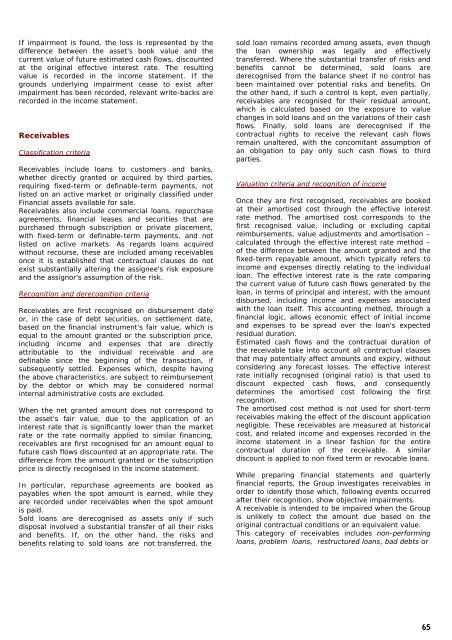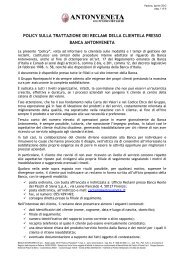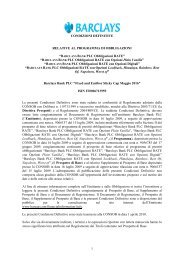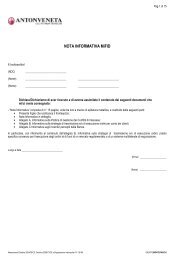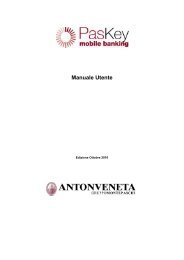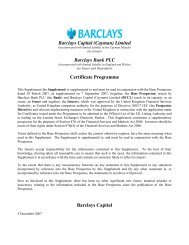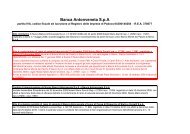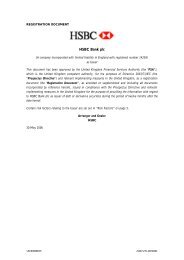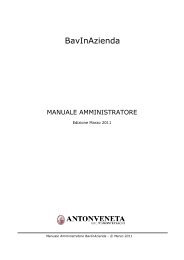996 - Banca Antonveneta
996 - Banca Antonveneta
996 - Banca Antonveneta
Create successful ePaper yourself
Turn your PDF publications into a flip-book with our unique Google optimized e-Paper software.
If impairment is found, the loss is represented by thedifference between the asset's book value and thecurrent value of future estimated cash flows, discountedat the original effective interest rate. The resultingvalue is recorded in the income statement. If thegrounds underlying impairment cease to exist afterimpairment has been recorded, relevant write-backs arerecorded in the income statement.ReceivablesClassification criteriaReceivables include loans to customers and banks,whether directly granted or acquired by third parties,requiring fixed-term or definable-term payments, notlisted on an active market or originally classified underFinancial assets available for sale.Receivables also include commercial loans, repurchaseagreements, financial leases and securities that arepurchased through subscription or private placement,with fixed-term or definable-term payments, and notlisted on active markets. As regards loans acquiredwithout recourse, these are included among receivablesonce it is established that contractual clauses do notexist substantially altering the assignee's risk exposureand the assignor's assumption of the risk.Recognition and derecognition criteriaReceivables are first recognised on disbursement dateor, in the case of debt securities, on settlement date,based on the financial instrument's fair value, which isequal to the amount granted or the subscription price,including income and expenses that are directlyattributable to the individual receivable and aredefinable since the beginning of the transaction, ifsubsequently settled. Expenses which, despite havingthe above characteristics, are subject to reimbursementby the debtor or which may be considered normalinternal administrative costs are excluded.When the net granted amount does not correspond tothe asset’s fair value, due to the application of aninterest rate that is significantly lower than the marketrate or the rate normally applied to similar financing,receivables are first recognised for an amount equal tofuture cash flows discounted at an appropriate rate. Thedifference from the amount granted or the subscriptionprice is directly recognised in the income statement.In particular, repurchase agreements are booked aspayables when the spot amount is earned, while theyare recorded under receivables when the spot amountis paid.Sold loans are derecognised as assets only if suchdisposal involved a substantial transfer of all their risksand benefits. If, on the other hand, the risks andbenefits relating to sold loans are not transferred, thesold loan remains recorded among assets, even thoughthe loan ownership was legally and effectivelytransferred. Where the substantial transfer of risks andbenefits cannot be determined, sold loans arederecognised from the balance sheet if no control hasbeen maintained over potential risks and benefits. Onthe other hand, if such a control is kept, even partially,receivables are recognised for their residual amount,which is calculated based on the exposure to valuechanges in sold loans and on the variations of their cashflows. Finally, sold loans are derecognised if thecontractual rights to receive the relevant cash flowsremain unaltered, with the concomitant assumption ofan obligation to pay only such cash flows to thirdparties.Valuation criteria and recognition of incomeOnce they are first recognised, receivables are bookedat their amortised cost through the effective interestrate method. The amortised cost corresponds to thefirst recognised value, including or excluding capitalreimbursements, value adjustments and amortisation –calculated through the effective interest rate method –of the difference between the amount granted and thefixed-term repayable amount, which typically refers toincome and expenses directly relating to the individualloan. The effective interest rate is the rate comparingthe current value of future cash flows generated by theloan, in terms of principal and interest, with the amountdisbursed, including income and expenses associatedwith the loan itself. This accounting method, through afinancial logic, allows economic effect of initial incomeand expenses to be spread over the loan's expectedresidual duration.Estimated cash flows and the contractual duration ofthe receivable take into account all contractual clausesthat may potentially affect amounts and expiry, withoutconsidering any forecast losses. The effective interestrate initially recognised (original ratio) is that used todiscount expected cash flows, and consequentlydetermines the amortised cost following the firstrecognition.The amortised cost method is not used for short-termreceivables making the effect of the discount applicationnegligible. These receivables are measured at historicalcost, and related income and expenses recorded in theincome statement in a linear fashion for the entirecontractual duration of the receivable. A similardiscount is applied to non fixed term or revocable loans.While preparing financial statements and quarterlyfinancial reports, the Group investigates receivables inorder to identify those which, following events occurredafter their recognition, show objective impairments.A receivable is intended to be impaired when the Groupis unlikely to collect the amount due based on theoriginal contractual conditions or an equivalent value.This category of receivables includes non-performingloans, problem loans, restructured loans, bad debts or65


